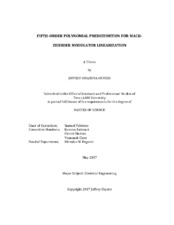| dc.contributor.advisor | Palermo, Samuel | |
| dc.creator | Okyere, Jeffrey Kwabena | |
| dc.date.accessioned | 2017-08-21T14:32:43Z | |
| dc.date.available | 2019-05-01T06:07:02Z | |
| dc.date.created | 2017-05 | |
| dc.date.issued | 2017-01-04 | |
| dc.date.submitted | May 2017 | |
| dc.identifier.uri | https://hdl.handle.net/1969.1/161299 | |
| dc.description.abstract | Modern wireless applications require access to ultra-wide instantaneous RF bandwidths to provide frequency agility and multi-band RF processing. Wireless communications, radar and electronic warfare are examples of applications that will benefit from wideband multi-function transceivers. The role of the front-end filtering is critical in order for the multi-function transceiver to achieve adequate RF performance. Integrated electric filters are unable to achieve the required frequency selectivity and tuning range mainly due to low Q of on-chip inductors. This renders a complete integrated solution impractical. Normally, high frequency and high selectivity filters are achieved with off-chip bulky SAW filters.
The limitation of electrical filters has motivated the employment of RF photonic receivers. The main issue with photonics is the cost but in recent times the emergence of silicon photonics has enabled the potential of RF photonics receivers to be implemented at a low cost. The use of photonics gives access to devices that can achieve really high Q and high integration at high frequencies.
At the heart of the photonic receiver is the Mach-Zehnder modulator (MZM). It modulates the received signal from the antenna to the optical carrier. The major issue with the MZM is: it is non-linear and wideband. The MZM is placed before the photonic filter and right after the antennae so interferers received with the desired RF signal generate intermodulation products at the output of the MZM. The intermodulation products can be very close to the desired RF signal so they cannot be filtered out by the photonic filter and may corrupt the desired RF signal. To curtail the effects of the MZM non-linearity, linearization schemes are implemented to reduce the amplitude of the intermodulation products generated when the MZM receives interferers.
This thesis work focuses on two main issues, Firstly, analysis of the intermodulation products generated by the MZM when a two tone RF signal is applied. Secondly, a literature review is done to examine the existing linearization schemes. Based on the predistortion linearization scheme, a new fifth-order predistortion is proposed. The proposed fifth-order predistortion is fabricated in GP 65nm TSMC CMOS process. The proposed fifth-order linearization achieves high IM3 suppression~ 20dB at high modulation index ~49.7% with 49.2mW of power consumed. | en |
| dc.format.mimetype | application/pdf | |
| dc.language.iso | en | |
| dc.subject | Mach-Zehnder modulator(MZM) | en |
| dc.subject | Vertical cavity surface emitting laser(VCSEL) | en |
| dc.subject | Electro-absorption modulator(EAM) | en |
| dc.subject | Directional coupler modulator | en |
| dc.subject | Ring resonator modulator | en |
| dc.subject | third-order intermodulation | en |
| dc.subject | fifth-order intermodulation | en |
| dc.subject | photodetector | en |
| dc.title | Fifth-order Polynomial Predistortion for Mach-Zehnder Modulator Linearization | en |
| dc.type | Thesis | en |
| thesis.degree.department | Electrical and Computer Engineering | en |
| thesis.degree.discipline | Electrical Engineering | en |
| thesis.degree.grantor | Texas A & M University | en |
| thesis.degree.name | Master of Science | en |
| thesis.degree.level | Masters | en |
| dc.contributor.committeeMember | Entesari, Kamran | |
| dc.contributor.committeeMember | Madsen, Christi | |
| dc.contributor.committeeMember | Choe, Yoonsuck | |
| dc.type.material | text | en |
| dc.date.updated | 2017-08-21T14:32:43Z | |
| local.embargo.terms | 2019-05-01 | |
| local.etdauthor.orcid | 0000-0001-9101-2733 | |


